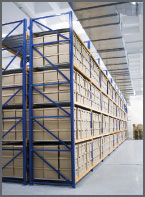Group A Plastics and High-Hazard Commodity Storage
Klausbruckner & Associates is a consulting firm specializing in fire and building code regulations. We provide unrivaled expertise and consulting services nationwide in the areas of high-piled storage including high-hazard commodities, Group A Plastics, palletized, bin box, and rack storage.
Our services include
High hazard commodity storage and warehousing is one of our specialties at Klausbruckner & Associates. We offer solutions to any warehouse, rack storage, palletized, or high-piled storage application. Whether it is facility construction, a change of occupancy, sustaining or maintaining fire code compliance based on changing business needs, or closure of plants and facilities, we will provide cost effective customized solutions for your business.
A plastic commodity can be classified as Group A, B or C, depending on its BTU/lb capacity. The storage of Group A Plastics, such as ABS, acetal, acrylic, butyl rubber, EPDM (ethylene propylene rubber), FRP (fiberglass reinforced polyester), expanded natural rubber, nitrile rubber, PET, polybutadiene, polycarbonate, polyester based elastomers, polyethylene, polypropylene, polystyrene (expanded or unexpanded), polyurethane (expanded or unexpanded), PVC (greater than 15 percent plasticized), SAN (styrene acrylonitrile), SBR (styrene butadiene rubber) a.o., presents fire protection challenges that require expert guidance (classifications are based on NFPA 13 2010). Then products containing Group A plastics may be reduced to a lesser commodity hazard category or classification, depending on the percentage of Group A plastics in the overall commodity.
These types of plastics come in either of two forms, expanded or unexpanded. Unexpanded plastics are higher density materials that may be formed into different shapes such as drums, containers, toys, etc. Expanded plastics are manufactured from similar plastic resins, but during the manufacturing process, usually a form of foaming process, small bubbles are created in the plastic. These foamed (expanded) plastics are much lower in density and they have a higher heat release rate than unexpanded plastics. Examples of finished products include insulation boards, packing beans, polystyrene foam coffee cups and plates.
Less hazard than Group A plastics are Group B and Group C plastics. Group B plastics include cellulosics, chloroprene rubber, fluoroplastics (ECTFE, ETFE, FEP), unexpanded natural rubber, nylon, PVC (polyvinyl chloride greater than 5-percent, but not exceeding 15-percent plasticized) and silicone rubber. Group C plastics include fluoroplastics (PCTFE, PTFE), melamine, phenolic, PVC (rigid or plasticized less than 5 percent), PVDC, PVDF, PVF, and Urea (NFPA 13 2010).
Frequently asked questions on the application of ESFR sprinklers can be found in our article titled ESFR Sprinklers - The Perfect Solution To Warehouse Fire Protection? Commonly asked questions on the application of sprinkler systems can be found in our article titled Sprinkler Protection Simplified.
Depending on what products you store, plus how you store them, you have several options that can be explored. Let us take care of your code compliance issues.
Call today at 1.619.677.2004 and experience one of the best services in the industry.
Fire & Building Code Information Pages
- High Piled Combustible Storage
- NFPA 13 - Installation of Sprinkler Systems
- NFPA 30 - Flammable and Combustible Liquids Code
- NFPA 30B - Manufacture and Storage of Aerosol Products
- Industry Specific Fire and Building Code Services
- Code Consulting Services Overview
- Commodity Classification Ordinary Combustibles
- Commodity Classification Hazardous Materials
Related Articles From Klausbruckner & Associates
Please contact us at Tel: +1-619-677-2004
Or visit us on the web at www.klausbruckner.com


